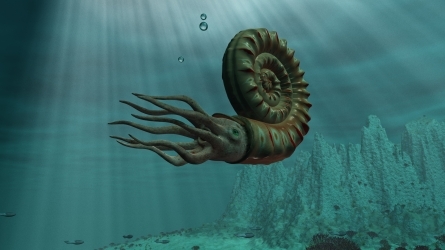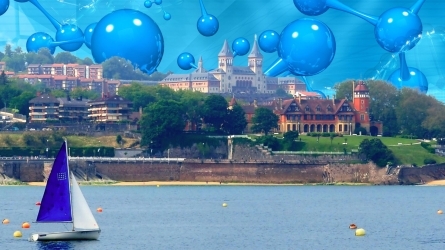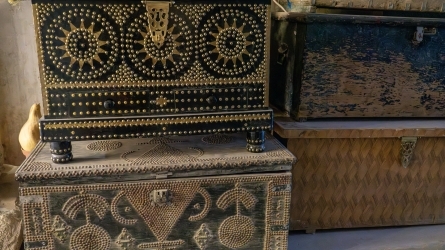
The Ammonoids of Mutriku: An Oceanic Heritage from 100 Million Years Ago.
This activity consists of a lecture accompanied by two practical activities: a visit to the Mutriku museum and the Flysch.
Description
This activity is part of the course program: 'Universities Looking at the Sea: Navigating Ocean Sustainability on the Training Ship Saltillo.'
Ammonoids are extinct cephalopod mollusks that formed one of the most diverse groups of invertebrates we know. They were abundant in the seas of our planet from 350 million years ago to approximately 65 million years ago, becoming extinct around the same time as the well-known dinosaurs.
The size of adult ammonoids ranges from 1 to 15 cm in diameter, but some groups deviate widely from these sizes, exhibiting shapes that can reach over 50 cm and even up to a meter in diameter.
The ammonoid fossils in Mutriku exhibit a wide range of morphologies and exceptional size compared to other sites of the same age (Albian, Middle Cretaceous; approximately 100 million years ago). The collection kept in the Nautilus museum contains more than 60% of specimens ranging from 35 to 50 cm in size, many of them being true giants when considering the average size of the represented families. Interestingly, these fossils had gone largely unnoticed by science until Jesús Narbaez and Esperanza Azkarraga from Arrasate, driven by their love for nature and innate curiosity, rescued them from coastal erosion and donated them for scientific research and the enjoyment of all.
To explain the large size of these fossil ammonoids, several lines of hypotheses have been proposed, which still require further study. In the marine environment, a large remains have a high chance of breaking and their fragments can disperse either through currents or biological activity, making their preservation in the fossil record challenging. The life cycle of the living being is an important factor. For example, a larger size could result from delayed sexual maturity, advantageous in certain situations (e.g., reproduction; larger females). The presence of large forms could explain reproductive behavior in a favorable environment. Environmental factors, such as episodes of high sea levels, allow the expansion of continental shelves with great potential for new ecological niches, or underwater volcanic episodes that contribute nutrients to the oceanic food chain.
Activity directed to
- All public
In collaboration with
Program
20-07-2023
Registro
“Alkatetzaren agurra“
- Alkatetza Ordezkaria Arrieta | Mutriku
“Mutrikuko ammonoideoak: duela 100 milioi urteko ozeano-ondarea / Los ammonoideos de Mutriku: un patrimonio oceánico de hace 100 millones de años“
- Mikel A. Lopez Horgue | UPV/EHU - Personal Docente e Investigador- Irakasle eta ikertzailea (Departamento de Geología- Geologia Saila)
“Landa-irteera Zazpi Hondartzak itsas labarrean (Flysch-ean ikasten)/Visita de campo a los acantilados de Zazpi Hondartzak (Aprendiendo en los flysch)“
- Mikel A. Lopez Horgue | UPV/EHU - Personal Docente e Investigador- Irakasle eta ikertzailea (Departamento de Geología- Geologia Saila)
Euskal kostaldeko geoparkea. Flysch-etan ikasten. Gidaria: Mikel López Horgue
Speakers

Mikel A. Lopez Horgue
Licenciado en Geología, UPV/EHU, 1988; beca predoctoral del Gobierno Vasco 1990-1994. Geólogo en la empresa privada en 1990 y 1995-1997. Doctor por la UPV/EHU en el año 2000. Profesor en la Escuela de Minas-UPV/EHU de 1998 a 2007. Entre 2004 y 2017 investigó sobre hidrotermalismo para la empresa TOTAL S.A.. En 2006 y 2007 se especializó en el estudio de faunas de ammonoideos (NHM Londres- beca Synthesis, 2007). Entre 2008 y 2015 ha sido profesor de campo en un curso internacional para empresas del petróleo. De 2017 a 2020 dirigió el departamento de Estratigrafía y Paleontología, hoy día parte del de Geología. Desde 2016 ha colaborado con Euskal kostaldeko Geoparkea en el estudio y divulgación de su patrimonio paleontológico. Investigador Principal del grupo del Gobierno Vasco sobre Paleontología y Geología de los Pirineos. Sus líneas son el análisis de cuencas sedimentarias, las faunas de ammonoideos y su paleoecología. Codirige una tesis sobre Estratigrafía del Aptiense-Albiense de Urdaibai.

Alkatetza Ordezkaria Arrieta
Venue
Zabiel Kultur Etxea
Erdikokale Kalea, 28, 20830 Mutriku, Gipuzkoa
Gipuzkoa
Zabiel Kultur Etxea
Erdikokale Kalea, 28, 20830 Mutriku, Gipuzkoa
Gipuzkoa





